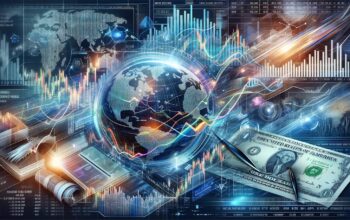Algorithmic trading, a pivotal development in modern financial markets, involves using computer algorithms to automate the trading of stocks or other assets. Pre-programmed to follow specific instructions, these systems decide when to open and close trades. Predominantly relying on complex software, algorithmic trading’s effectiveness is often enhanced through back testing, ensuring its accuracy and efficacy. A substantial majority of futures trades in major markets such as the E-mini S&P 500, NASDAQ, gold, and oil are now executed algorithmically, indicating its widespread adoption.
Fundamentals of Algorithmic Trading
In the realm of trading, algorithms are intricate processes designed to execute sets of instructions. They incorporate various variables, including an asset’s price, volume, and timing, to determine the optimal trading moments. While algorithms operate autonomously, human oversight is integral for adjustments based on retrospective performance analyses.
Key Elements in Algorithmic Trading
Algorithmic trading systems factor in an asset’s moving average, trading activity types, volume, and price. They also account for broader market trends, such as widespread sell-offs and corrections. With advanced computing power, these systems can execute thousands of trades in a fraction of a second, particularly in volatile markets like futures gold or NASDAQ.
Historical Context and Evolution
Originating in the mid-1970s with the New York Stock Exchange’s electronic systems, algorithmic trading has evolved significantly. The E-mini S&P was among the first futures indices to be traded algorithmically. Over the years, advancements in machine learning have refined these algorithms, reducing the reliance on human intervention. Currently, algorithmic trading spans a spectrum from individual investors to large trading corporations.
The evolution of algorithmic trading is a testament to its efficiency in modern financial markets. Starting with a mere 15% of American market trades in 2003, algorithmic trading experienced rapid growth, especially around the 2007 Great Recession. By 2012, an overwhelming 85% of trades in American stock markets were executed algorithmically.
Profitability and Challenges in Algorithmic Trading
While institutional investors often reap substantial profits from algorithmic trading due to their capacity for high-frequency, high-volume trading, retail investors face more challenges. The lack of sophisticated software or hardware, along with higher relative trade costs, can diminish profitability for smaller-scale traders. However, those who develop low-latency algorithms can still achieve notable profits despite these obstacles.
Targets Trading Pro offers resources and insights for various futures, providing an avenue for investors to leverage algorithmic trading effectively.
Essential Disclaimers and Considerations
- Government and Regulatory Disclaimers. Investing in futures and options carries significant risks and rewards. Prospective investors must understand and accept these risks. Information provided on related websites should not be construed as a solicitation or offer to buy or sell these instruments. Past performance is not indicative of future results;
- Limitations of Hypothetical Performance. Per CFTC Rule 4.41, hypothetical or simulated performance results have inherent limitations. They do not represent actual trading and may not accurately reflect the impact of market factors like liquidity. No assurance can be given that any account will achieve similar profits or losses;
- Non-Endorsement of Trading Practices. Performance results should not be seen as endorsements or recommendations for trading. The provider, being a trader and educator, aims to demonstrate trading efforts without acting as a broker-dealer or financial advisor. The trades are not recommendations for others to trade live accounts.
The Broader Impact of Algorithmic Trading
Market Efficiency and Accessibility
Algorithmic trading has significantly contributed to the efficiency and accessibility of financial markets. By automating complex trading strategies, it has democratized access to sophisticated trading techniques, previously the domain of large institutional investors.
Technological Advancements and Market Adaptation
The advancement in technology, particularly in computing power and machine learning, has been a driving force in the evolution of algorithmic trading. These technological improvements have enabled traders to analyze vast amounts of market data, execute trades with precision, and adapt strategies in real-time.
Ethical and Regulatory Considerations
As algorithmic trading becomes more prevalent, ethical and regulatory considerations have surfaced. Issues like market fairness, transparency, and the potential for algorithmic manipulation have prompted regulatory bodies to closely monitor and adapt regulations governing automated trading practices.
The Future of Algorithmic Trading
Looking ahead, algorithmic trading is poised to become even more integrated into financial markets. With continual advancements in artificial intelligence and data analytics, the potential for developing more sophisticated and efficient trading algorithms is vast. This progression suggests a future where algorithmic trading could dominate market transactions, necessitating ongoing adaptation by traders and regulators alike.
Educational and Skill Development
For individuals interested in algorithmic trading, continuous education and skill development are crucial. Understanding algorithmic concepts, staying updated with market trends, and developing programming skills are essential for effectively navigating this field. Participation in financial courses, workshops, and seminars can provide valuable knowledge and insights into the nuances of algorithmic trading.
The rise of algorithmic trading marks a significant shift in the landscape of financial markets. Its ability to execute complex strategies at unprecedented speeds has revolutionized trading practices, making markets more efficient and accessible. However, this evolution also brings challenges, including the need for enhanced technological capabilities, ethical considerations, and regulatory oversight.
For investors, whether institutional or retail, understanding the intricacies of algorithmic trading is essential for success in this new era. Leveraging tools like Targets Trading Pro can provide valuable insights and support in navigating these complex waters. As the financial world continues to evolve, embracing the advancements and learning to adapt to the changing dynamics of algorithmic trading will be key to achieving long-term profitability and success in the markets.
Understanding the Risks in Futures Trading
- Evaluating the Potential Losses. In the world of futures trading, significant risks loom over every decision made by traders. Individuals venturing into this domain must thoroughly assess whether this form of trading aligns with their financial situation. The risks associated with futures trading are multifaceted, and they demand careful consideration;
- The Peril of Total Loss. When engaging in the purchase or sale of a futures contract, traders expose themselves to the possibility of incurring a total loss. This includes not only the initial margin funds but also any additional funds deposited with their broker to establish or maintain their position. Consequently, futures trading may not suit everyone, and participants must comprehend that they could lose a portion or even the entirety of their invested capital;
- Contingent Orders and Their Limitations. Contingent orders, such as “stop loss” or “stop limit” orders, are frequently utilized to mitigate potential losses. However, it is crucial to recognize that these orders do not guarantee the limitation of losses to the intended amounts. Unpredictable market conditions can thwart the execution of such orders;
- The Double-Edged Sword of Leverage. Leverage, a hallmark of futures trading, can either work in favor of traders or turn against them. While it has the potential to yield substantial gains, it equally poses the risk of incurring substantial losses. The ability to control large positions with relatively small margin deposits amplifies both profit and loss possibilities;
- Volatility and Unpredictability. Futures prices are notorious for their volatility and unpredictability. An array of factors, encompassing politics, economics, and other external forces, can significantly influence the price movements of futures contracts. These factors often operate outside the realm of control for both trading systems and brokers;
- The Dependence on Technology. In the contemporary landscape of futures trading, computer systems play a pivotal role in generating trading signals. The efficacy of trading systems is highly dependent on the proper functioning of these systems. Failures, whether attributed to third-party dependencies or broker hardware and software malfunctions, can disrupt trading operations. Such disruptions, even if brief, can result in significant trading losses or missed profit opportunities under specific market conditions.
The Technical Nature of Trading Systems
The trading systems available in the market are inherently technical in nature. Their profitability hinges on various factors, with one of the primary determinants being the occurrence of substantial price trends. These trends constitute sustained movements, either upward or downward, in futures prices. However, it is imperative to acknowledge that such trends do not invariably manifest. Historical periods exist where price trends were absent.
- The Challenge of Hypothetical Performance. Hypothetical performance results, a common point of reference for traders, come with inherent limitations. These results are typically generated in hindsight, providing a retrospective view of trading performance. Furthermore, hypothetical trading does not entail actual financial risk, and as such, it cannot fully encompass the impact of financial risk in real-world trading scenarios;
- Prerequisites for Trading. Before engaging in futures trading, prospective investors must fulfill certain prerequisites. Most notably, they need to establish relationships with brokers and meet suitability requirements. This process ensures that traders are adequately prepared to navigate the intricacies of trading these specific financial instruments;
- Acknowledging Responsibility. By accepting the terms of this disclaimer, traders explicitly recognize the inherent risks entailed in futures trading. It underscores that traders, as subscribers, bear sole responsibility for any financial losses or other consequences resulting from their use of trading systems provided;
- Disclaimers and Liability. The disclaimer further absolves TRB Futures LLC from various liabilities. It disclaims responsibility for lost profits, missed opportunities, misstatements, or errors within the provided materials. Additionally, it underscores that TRB Futures LLC will not be held accountable for data accuracy, server issues, or any special or consequential damages arising from the use or inability to use the materials published on their website;
- Legal Protection and Indemnification. In an effort to establish legal protection, the disclaimer stipulates that users agree to hold TRB Futures LLC harmless for any actions stemming directly or indirectly from the website, its data, content, materials, associated pages, and documents. Users also pledge to defend, indemnify, and shield TRB Futures LLC and its affiliates from any claims, liabilities, costs, and expenses arising from their use of any services provided by TRB Futures LLC;
- The Information “As Is”. Lastly, the disclaimer asserts that TRB Futures LLC offers information, services, and products on its website “as is,” without warranties of any kind. It also specifies that TRB Futures LLC, its managers, agents, and employees shall not be liable for any loss or injury, direct or indirect, incidental, consequential, special, or exemplary, arising from the use or performance of the website or any information, services, or products provided through it.

Conclusion: Navigating the Waters of Futures Trading
In the realm of futures trading, the road to financial success is laden with complexities and risks that demand vigilance, knowledge, and strategic planning. As traders contemplate entering this dynamic arena, they must recognize the multifaceted nature of futures trading and take into account the extensive considerations outlined in the preceding sections.
The primary lesson that emerges from this discourse is that futures trading is not a one-size-fits-all endeavor. It requires a thorough understanding of the market, risk tolerance, and trading objectives. Traders should embark on this journey with a clear awareness of their financial condition, fully comprehending that the potential for substantial loss looms large. One of the fundamental facets of futures trading is the concept of leverage, a double-edged sword that can both amplify gains and magnify losses. Traders must tread carefully in leveraging their positions, as it can significantly impact their bottom line. Prudent risk management and capital preservation should be paramount in their trading strategies.
The volatility and unpredictability of futures prices underscore the importance of staying informed about various market dynamics. Political, economic, and external factors beyond a trader’s control can influence price movements. Consequently, maintaining flexibility and adaptability in trading strategies is key to navigating these turbulent waters. The role of technology in futures trading cannot be overstated. In an era where computer systems generate trading signals, traders are reliant on the proper functioning of these systems. The risk of system failures, whether stemming from third-party dependencies or broker hardware and software issues, necessitates a contingency plan and risk mitigation measures.
Furthermore, traders should be aware of the technical nature of trading systems and the need for sustained price trends to ensure profitability. Past performance, often referenced through hypothetical results, serves as a guide, but it should be approached with caution due to its retrospective nature. Prior to embarking on their futures trading journey, traders must fulfill prerequisites, including establishing relationships with brokers and meeting suitability requirements. These steps ensure that traders are adequately prepared to engage with futures markets. In accepting the responsibility outlined in disclaimers, traders acknowledge that they are the architects of their own futures trading destinies. They commit to holding themselves accountable for the outcomes of their trading decisions.
In conclusion, futures trading is a realm of great potential, but it is also one that demands meticulous preparation and continuous learning. Traders who navigate these waters with prudence, resilience, and adaptability can harness the opportunities presented by futures markets while effectively managing the associated risks. Success in futures trading hinges on knowledge, discipline, and a commitment to responsible trading practices.



